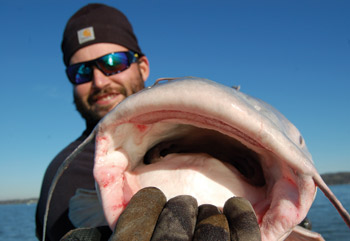
Potomac River Capt. Josh Fitchett targets only the biggest of catfish.
“Don’t touch that rod,” commanded Captain Josh
Fitchett, a split second before I otherwise would have reached for the
second fishing rod in his spread. “That’s not the one you want.”
That surprised me because only one of the 10 rods was
bobbing and twitching and generally acting like it was seconds away
from being pulled into the drink.
“Watch the one next to it instead,” he said. Odd, that one was perfectly still.
The moving rod was being besieged by what Capt. Josh
typically refers to as a “sniffer” or a “nibbler.” Neither of those
terms is complimentary. In fact, they’re downright derisive. Those
types of fish might eat the guts out of a pound-plus slab of
freshly-caught shad, but they’re not big enough to engulf the whole
thing.
Capt. Josh only cares about big cats, the kind that could
swallow whole shad, basketballs, perhaps small dogs or deer. Thirty
pounds doesn’t excite him. Eighty pounds excites him. A hundred pounds
is what keeps him coming back out on the Potomac River, fishing within
sight of the Washington Monument.
As predicted, rod No. 2 stopped gyrating a few seconds
later. Rod No. 3 suffered no such spasms, however. Instead, after two
long pulls it settled into a horseshoe arc that strained the rod
holder. I pulled it free, set the hook, and in a few minutes a 48-pound
blue cat lay in the net in the bottom of the boat. A short while later
and with a little more struggle, my wife subdued a 59-pounder. Minutes
after that, my friend TJ Maglio was eye to eye with a 51. After a
while we also perceived 30-pounders, citations , as mere nuisances.
As I looked at the waypoints on Fitchett’s GPS, he
explained “That’s every place I’ve caught a 60-pounder since I got this
unit.” It appeared to be last year’s model. The waypoints were so
cluttered that in some places they blacked out the topographical
symbols. “Forties are OK. Fifties make me happy. Sixties make me dance
in the boatyard.” For a grizzled catfish veteran, he must do a lot of
dancing.
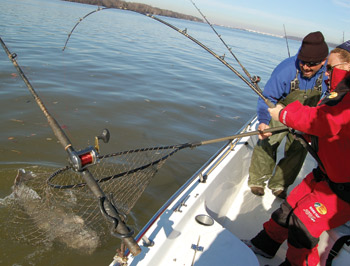
Fitchett slides the net under a trophy cat within sight of the Woodrow Wilson Bridge.
Center of the Cat Universe
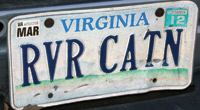 While
blue catfish are not native to the Potomac River watershed – or any of
the mid-Atlantic rivers, for that matter – they thrive in the fertile
moving waters of Virginia and Maryland. Their native range is largely
in the middle of the country, where they grew big in river systems like
the Mississippi, Missouri and Ohio, but once introduced to the tidal
James and Rappahannock Rivers in the 1970s, it quickly became evident
that they’d thrive in the east as well.
While
blue catfish are not native to the Potomac River watershed – or any of
the mid-Atlantic rivers, for that matter – they thrive in the fertile
moving waters of Virginia and Maryland. Their native range is largely
in the middle of the country, where they grew big in river systems like
the Mississippi, Missouri and Ohio, but once introduced to the tidal
James and Rappahannock Rivers in the 1970s, it quickly became evident
that they’d thrive in the east as well.
The James River in particular has become a popular Mecca
for big blue cats, with a thriving cadre of guides (Fitchett among
them) luring anglers from near and far to tangle with what may be the
biggest freshwater fish of their lifetime. In 2009, a local angler
caught a James River blue that pushed the scales to 102 pounds, 4
ounces. That, in turn, was dwarfed by the 143-pounder caught at
Virginia’s Buggs Island Reservoir in 2010. But the big lake-bound cats
don’t seem to be as plentiful as the river run beasts. Fitchett thinks
it’s only a matter of time until the Potomac officially produces one in
the triple digits. He claims to have twice lost such a fish en route
to the net.
“This is such a dynamic river system,” he said. “It’s
probably the best freshwater tidal bass fishery on the East Coast. It’s
a fantastic crappie fishery. Even the snakeheads are taking off and
we’re regularly seeing 13-, 14- and 15-pounders. Between the structure
and the grass and the freshwater mussel beds, this river has got a
little bit of everything and a whole lot of fish. It’s a guide’s dream.
“Someday, someone will set up a guide service here that’ll
take you out to catch a 40-pound blue cat in the morning and a 5-pound
bass in the afternoon. It’s something that can be done every day of
the week.”
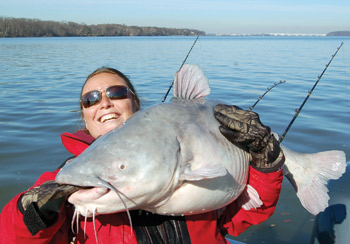
A happy client strains under the weight of a big cat. Women and children are encouraged to partake in the fun.
A Growing Legion
While the bass guys show up on the Potomac in huge numbers
every weekend from March through November, towing metal-flaked boats
and wearing color-coordinated jerseys, the numbers of local catfish
chasers are likewise growing. It’s just that they’re not as noticeable.
A 60-pounder’s slime will require that you take your sponsor-logoed
shirt to the dry cleaners every trip out, so it’s not worth getting all
dolled up. They’re hard on bass boat carpet, too.
Still, on a blustery December weekday, we saw a number of
boats with rigs spread out over key river drop-offs, ledges and humps,
all looking for blue dynamite. The tournament scene is growing, too,
sometimes drawing as many as 200 boats to a weekend derby. Like the
secretive bass pros and wannabe pros, though, there’s an increasing
divide between those who “get it” and those who just follow the bent
rod pattern.
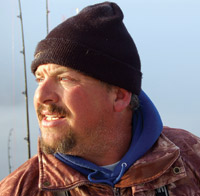 Fitchett
said that consistently landing the big ones, and numbers of them,
requires more than just a pile of smelly bait on the river channel. In
fact, while the cat gurus may not have borrowed the bass anglers’
wardrobe choices, a lot of their key strategies sound remarkably
similar to those employed by the best offshore bassers. If that weren’t
enough, the tournament circuits, while still nascent, are on their way
to becoming every bit as competitive, cutthroat and eventually perhaps
as lucrative as those for the largemouth hounds.
Fitchett
said that consistently landing the big ones, and numbers of them,
requires more than just a pile of smelly bait on the river channel. In
fact, while the cat gurus may not have borrowed the bass anglers’
wardrobe choices, a lot of their key strategies sound remarkably
similar to those employed by the best offshore bassers. If that weren’t
enough, the tournament circuits, while still nascent, are on their way
to becoming every bit as competitive, cutthroat and eventually perhaps
as lucrative as those for the largemouth hounds.
Like the bass tournament guys, Fitchett has learned that
it’s “not all about spots.” When he goes to a new tidal water – like
the Rappahannock, Mattaponi or Pamunkey, all within a short drive of
the more popular James and Potomac – he’s looking for structural
elements that are prime time feeding areas, too.
“I want to find deep turns and drop-offs with water flow
hitting them and then turning,” he said. “I especially like real sharp
turns where the current hits the bank.”
While Potomac River bass chasers often try to time the
tide to be in their best spots on the last two hours of the outgoing
tide, Fitchett said that the key is tidal movement. “I don’t like
extremely high current,” he explained. “I like the beginning and the
end of moving tides. The middle can be a little bit slow.”
Accordingly, he may leave a prime area to attain a more
favorable flow elsewhere. Otherwise he may set up differently on the
same ridge under varying tidal conditions. For example, an incoming
tide might find him up on the ledge casting out, while outgoing could
be the reverse. Or he might set up upriver for one and downriver for
the other. He’s always mindful to “let the current pull the bait to the
fish.”
Another key element most times is deep water, or at least
access to it. In the summer, at night, he may catch monster blues as
shallow as 8 feet deep, but there has to be a trough nearby. He’s
caught them as deep as 90 feet on the James, but the Potomac doesn’t
have as many of those ultra-deep areas – 60 seems to be the typical
outer limit.
Big Tackle a Must
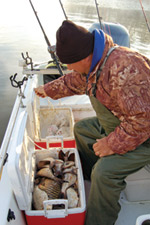 Fitchett
will run “eating fish trips” for customers who want them, chances to
catch a hundred plus smaller fish on chunks of shad, chicken liver or
little pieces of herring, but his obsession is with the big whiskered
freaks. Most of his clients follow suit. For those used to pursuing
panfish, toying with trout or busting two-and three-pound bass, the
opportunity to catch a fish that weighs more than a third-grader is too
much to pass up. This requires beefy tackle and appropriate bait.
Fitchett
will run “eating fish trips” for customers who want them, chances to
catch a hundred plus smaller fish on chunks of shad, chicken liver or
little pieces of herring, but his obsession is with the big whiskered
freaks. Most of his clients follow suit. For those used to pursuing
panfish, toying with trout or busting two-and three-pound bass, the
opportunity to catch a fish that weighs more than a third-grader is too
much to pass up. This requires beefy tackle and appropriate bait.
Those who try to tempt big cats with just random stinky
stuff are going to leave the water without success. They may be
predators, but they’re not indiscriminate eaters. “The key is fresh
bait,” he said, and we used slabs of fresh gizzard shad he’d captured
that day, probably a pound per chunk. The bait alone requires the
proper rods, reels and line to manage it, but it’s the hard-pulling
cats that ultimately create the need for warrior-class gear.
“Most guys don’t use heavy enough tackle to bring ‘em to
the boat,” he said. “I can’t tell you how many 30 and 40 pound blue
cats I’ve caught with a bottom rig hanging out of their mouth along
with a 4-ounce triangular sinker.”
Indeed, his own recent break offs with 80-pound leader
material had led him to beef up to 100-pound class line in its stead.
If these fish keep growing, eventually he’ll have to go to well rope.
He uses a 50-pound main line to get the bait down and has tried a
number of different reels.
Eventually, most seem to be worn down by the brute-force
strength of the cats he battles day in, day out. The one that seems to
be the most bulletproof is the Shimano Tekota 600 and he mounts them on
rods that might seem more at home on a tuna boat than on one of the
nation’s best tournament bass fisheries.
The other part of getting a bait down to the bottom and
keeping it there in tidal currents is the size of the lead weight that
Capt. Josh employs. Many other cat chasers prefer 8- or 10-ounce
weights, but his custom-poured hockey puck shaped sinkers push the
scale down to a full 16 ounces.
“When I fish anything lighter, I don’t get the same hookup
ratio,” he said. “And if I use any more weight the fish will feel it.”
He uses an 8/0 Gamakatsu circle hook to keep the fish safely buttoned,
but admitted that he’d go up to a 10/0 if he could find one.
Don’t Stop Till You Get Enough
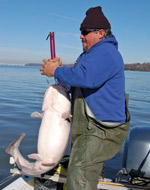 For
a die-hard trophy chaser like Fitchett, the Mid-Atlantic rivers offer a
conundrum: there’s no offseason to allow his arms, shoulders and back
to recuperate and to gear up for the season to come. Except for a brief
window between Mother’s Day and Father’s Day when the fish are
spawning, the game is always on. During the hottest portions of the
summer, he focuses his efforts on nighttime excursions – not only do
the fish bite better, but he can keep some of his secrets away from
prying eyes.
For
a die-hard trophy chaser like Fitchett, the Mid-Atlantic rivers offer a
conundrum: there’s no offseason to allow his arms, shoulders and back
to recuperate and to gear up for the season to come. Except for a brief
window between Mother’s Day and Father’s Day when the fish are
spawning, the game is always on. During the hottest portions of the
summer, he focuses his efforts on nighttime excursions – not only do
the fish bite better, but he can keep some of his secrets away from
prying eyes.
The year-round bounty is fine with him. He’s been a
fishing freak since boyhood, when he wore out the bottom of a 14-foot
Sears Gamefisher Jon Boat, pulling it to local waterways – literally dragging
it down pockmarked country roads until it was no longer seaworthy.
Today he knows that resources have to be protected – thus his trophy
trips are all catch and release. He’s seen what increased pressure can
do to a fishery.
The James River remains one of his favorite destinations,
but despite the relatively recent 102-pounder, he thinks it’s no longer
what it once was. With 20-plus guides plying its waters, all in search
of monster blues, it’s become a tougher bite.
“But up here,” he said, referring to the Potomac, “just
about every trip we catch a 40-pounder.” That’s nothing to sneeze at.
Just make sure you grab the right rod – those 30-pounders are just so
pesky and tiresome when the next bite could be a 50, a 60 or a
whiskered heavyweight that hits the century mark.
Epilogue: On August 13, Fitchett led a
client from Oregon to an 84-pound Potomac River blue catfish, eclipsing
the previous state record by more than three pounds. After it was
weighed and certified by a Maryland DNR Fisheries Service biologist,
the fish was tagged and released to aid in the future understanding of
the habits and distribution of the non-native species.
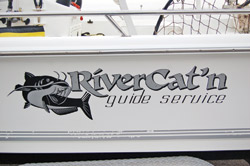
Despite the thousands of pounds of catfish slime deposited
on it each year, Fitchett's boat remains remarkably clean.